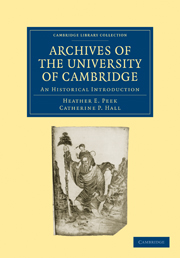Book contents
- Frontmatter
- Contents
- List of Plates
- Preface
- PART I
- PART II
- 4 The University and Colleges as Privileged Corporations
- 5 Records of University Administration
- 6 Records of Matriculation and Degrees
- 7 Financial Records of the University
- 8 Endowments of the University
- 9 University Officers and their Records
- 10 Records of the University Courts
- 11 Records of University Jurisdiction in the Town of Cambridge
- 12 The Relations between the Crown and the University
- 13 Other University Institutions and their Records
- APPENDICES
- Index
- Index to Muniments of Title in Appendix B
- Plate section
5 - Records of University Administration
Published online by Cambridge University Press: 07 September 2010
- Frontmatter
- Contents
- List of Plates
- Preface
- PART I
- PART II
- 4 The University and Colleges as Privileged Corporations
- 5 Records of University Administration
- 6 Records of Matriculation and Degrees
- 7 Financial Records of the University
- 8 Endowments of the University
- 9 University Officers and their Records
- 10 Records of the University Courts
- 11 Records of University Jurisdiction in the Town of Cambridge
- 12 The Relations between the Crown and the University
- 13 Other University Institutions and their Records
- APPENDICES
- Index
- Index to Muniments of Title in Appendix B
- Plate section
Summary
The continuous administrative records of the university begin in 1454 with the series of Grace Books, which extends unbroken to 1880. The earliest Grace Books, A and B, contain the undifferentiated records of University business, both financial and administrative, from 1454 to 1500, and were kept by the proctors. They are sometimes called by their earlier title, ‘Registra Procuratorum’. After 1500, the proctors continued to keep their annual financial records in Grace Book B, until the book was filled in 1544, and thereafter in a separate series of audit books. The other administrative business of the university, chiefly in the form of c Graces of the Senate ’, was recorded in a new register, Grace Book Γ. This register is, from its inception in 1501, kept by one person, the hand not changing annually as in the ‘Registra Procuratorum’, and its writer and custodian was probably Robert Hobbys, esquire bedell, who became the first registrary in 1506. From this date until 1880, the Grace Books were kept by the registrary. Grace Books A and B, covering the period 1454-1544, have been published in the Luard Memorial Series by the Cambridge Antiquarian Society, and Grace Books Γ and Δ, covering the period 1501-89, have been published by the Cambridge University Press. The introductions to this series of published Grace Books form an invaluable commentary on the volumes themselves, and on the administration which produced them. They show, among other things, how the ‘Grace’, originally a personal exemption from statutory requirements granted by the senate to those aspiring to a degree, came to serve wider and more general purposes.
- Type
- Chapter
- Information
- Archives of the University of CambridgeAn Historical Introduction, pp. 27 - 30Publisher: Cambridge University PressPrint publication year: 1963First published in: 1962



